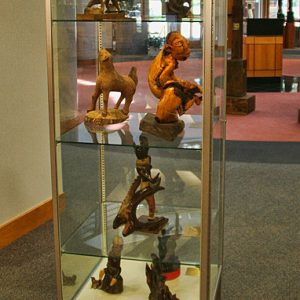calsfoundation@cals.org
Cicero Osco Pilgrim (1927–1973)
Cicero Osco Pilgrim was a self-taught African-American sculptor whose works express a highly personal and often humorous vision, showing little influence from African or European traditions. They have been collected by the Faulkner County Museum, numerous Conway families, and Hendrix College, where eleven items are on permanent display in the library.
Cicero Pilgrim was born on December 4, 1927, into a black community near Wooster (Faulkner County). His mother was Beulah Wilson Walker Pilgrim; his father’s surname was Pilgrim, but his Christian name is unknown. Pilgrim’s education ceased after the third grade. On June 21, 1953, he married Lee Ethel McCray; they had eight children. On a small farm near his birthplace, he and his family raised farm animals, gardened, fished, gigged frogs, and hunted small animals. Pilgrim also took a variety of jobs for cash—brick-laying, roofing, and tree trimming and removal. During the 1950s, he worked on a section gang laying and repairing track for the Missouri Pacific Railroad. At night, using pocketknives and carpenter’s tools, Pilgrim carved his sculptures at the kitchen table.
The Last Days (ca. 1967) is Pilgrim’s masterpiece. It features two women, one with a tiny child at the highest point of the piece, and the other seated—relaxed, nude, and sensual. Around the women, four birds cling to the wood, three animals attempt to hide, and a fourth animal threatens the world beyond the carving. The doomsday message of The Last Days contrasts with the humor of such works as Nat King Cole with Sailfish and Smiling Dog. Other notable works include Dark Woman, Abe Lincoln, Flying Bear, and Spotted Horse.
Beginning in the 1960s, Pilgrim would offer his sculptures for sale to people in Faulkner County who had hired him to trim their trees. His art became generally known in the area through this means. In the early 1970s, the art department of Hendrix College recognized Pilgrim’s talent and organized a show in the Trieschmann Gallery to celebrate his work.
Pilgrim died of a heart attack on August 13, 1973, and is buried at Pilgrim Rest Baptist Church near Wooster.
For additional information:
Carpenter, Gary. “The Sculpture of Cicero Pilgrim.” The College Profile (Hendrix College). April 1, 1974, p. 7.
Chumley, David. “Drive for Carving Purchase Nears End.” The College Profile (Hendrix College). April 1, 1974, p. 3.
“Pilgrim’s Works Are Shown at Hendrix.” Log Cabin Democrat. March 7, 1974.
Bill Hawes and Ashby Bland Crowder
Hendrix College
 Arts, Culture, and Entertainment
Arts, Culture, and Entertainment World War II through the Faubus Era, 1941 through 1967
World War II through the Faubus Era, 1941 through 1967 The Last Days by Cicero Pilgrim
The Last Days by Cicero Pilgrim  Cicero Pilgrim Sculptures
Cicero Pilgrim Sculptures 




Comments
No comments on this entry yet.